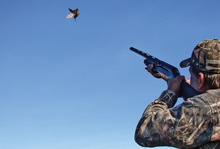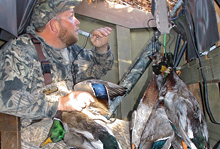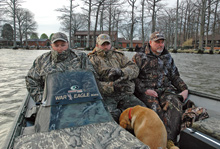November 03, 2010
By John E. Philips
The South's Real Deal.
By John E. Philips
 Comin' down. |
"Take 'em, boys," Billy Blakely, an avid waterfowler who hunts Tennessee's Reelfoot Lake, shouted in a loud whisper.
As I popped up through the porthole of the large stationary blind just after eating breakfast, I saw 20 mallards coming in with their feet outstretched, wings cupped and uh-oh-we-made-a-bad-mistake looks on their faces. One greenhead tried to up-shift gears as I tumbled him. The second greenhead already had pulled up and veered to my right before I swung on him. However, I heard the report of the duck hunter's gun next to me and that mallard began to fall. Quickly I swung up and spotted another greenhead straight overhead. After two quick shots, that mallard almost fell into our blind. Our party had dropped eight greenheads, finishing off our limits by 9:30 am.
Advertisement
One of my hunting buddies laughed as he observed, "Reelfoot Lake is the real deal for hunting ducks. I've never been on a better duck hunt in my life."
A major disaster in December 1811 through February 1812 created some of the best duck hunting in the nation as a series of earthquakes broke the earth's crust near Tiptonville, Tennessee. The huge size of the fissure caused the Mississippi River to run backwards into it and filled it with trees, limbs and bushes. This natural phenomenon created the 18,200-acre Reelfoot Lake, one of the best duck hunting and fishing areas in the nation.
Advertisement
Thirty-eight year old Billy Blakely has lived on the banks of Reelfoot Lake his entire life and duck hunted and fished there. As the chief guide at Blue Bank Resort on Reelfoot, Blakely hunts every day of Tennessee's three duck seasons.
"We have four waterfowl refuges on Reelfoot — Long Point, Grassy Island, Black Bayou and Lake Isom," Blakely says. "Combined, there are 20,000 to 25,000 acres of duck refuge land on Reelfoot." During the fall migration, these four refuges often concentrate 600,000 to 700,000 ducks that travel up and down the Mississippi Flyway.
The Two Early Seasons
The first season of duck hunting, the teal and wood duck season, usually arrives the second week of September and lasts for five days. Then around the second week of November, Reelfoot has a two-day duck season when hunters primarily take gadwalls, wigeons and a few mallards.
"During teal and wood duck season, we put out decoys in potholes in the lily-pad fields," Blakely reports. Blakely and the other Reelfoot guides use teal decoys during this season. Most of the hunting's done from boat blinds, allowing hunters much-more mobility to move to different potholes to keep from overshooting any one pothole. A hunter can take four ducks, either four teal, or two teal and two wood ducks in this season.
"We usually can limit out in 30 to 45 minutes during this first season, when the ducks fly and decoy well, and then either go crappie or bass fishing," Blakely reports. Combining duck hunting and either crappie or bass fishing gives a sportsman a great day in the lilies and cypress trees at Reelfoot, and he'll go home with limits of ducks and crappie or bass.
 Talking to the next flock. |
The Last Season
The last duck season's the primary season for duck hunting on Reelfoot. Most guides and hunters hunt then from the 200-stationary blinds permitted on Reelfoot Lake, although hunters still can use pop-up blinds and other types of boat blinds. Blakely and the other guides at Blue Bank Resort have made these big blinds their homes away from home.
Blakely has hunted for eight years from the same blind that has a steel hull and a wooden top half. Twenty-four feet long and eight feet wide with 10 shooting stations, the blind holds a stove, heaters, benches and many other home-like conveniences.
As Blakely reports, "In a blind this big, I can stay warm, make coffee and cook hot meals for my hunters." Blakely and the Blue Bank guides will put out at least 600 decoys around each of those blinds in this late waterfowl season. "We need big decoy spreads to help pull in the ducks moving from refuge to refuge and traveling back and forth, and up and down the Mississippi River," Blakely reports. "From experience, we know when and when not to call to these yo-yo ducks, as we call them."
Early in the third duck season, hunters generally will take a mixed bag of ducks, primarily wigeons, gadwalls and mallards, but later in the season, they'll bag about 85-percent mallards. Reelfoot's an unusual duck-hunting area because hunters can enjoy productive days when a warm front moves onto the lake just as they will on days with severe cold fronts coming from the North.
According to Blakely, "On cold fronts, we catch the ducks as they're moving from north to south on the Mississippi River. The ducks that fly down the Ohio and the Mississippi rivers meet in Cairo, Illinois, and catch the train heading for Reelfoot Lake. Then when a warm front comes through, we have ducks moving from south to north. So, during any weather change, we'll have new ducks coming into our area."
Blakely's Late-Season Setup
Blakely does most of his duck hunting from a stationary blind set up close to a pothole and hidden in grass marsh during the late season. Blakely places about 600 decoys around his blind with mallard decoys in front of his blind and coot decoys behind the mallard decoys. Blakely mixes Filler Killer decoys, large black jugs, in with his coot decoys. Blakely also puts gadwall decoys in his spread in a little cluster by themselves, close to the blind.
He also uses three spinning wing decoys, and a couple of spalshers to stir or kick up water and make ripples." To make the water appear muddy as though ducks have fed there, Blakely uses a generator and a water pump. Blakely also runs this pump to keep the shallow water where he hunts from freezing.
"Large patches of black decoys in the middle and on the sides of your spread will pull more ducks into your blind," Blakely says. "Although the Filler Killer decoys are as big as goose decoys, they don't have heads and don't look like anything but black buoys. But ducks will come from long distances and drop into these black decoys. I also place Canada goose decoys off to the side of my blind to give high ducks more confidence that my decoy spread is actually a waterfowl feeding area. Too, geese occasionally fly over Reelfoot, so having geese decoys out tempts the geese to come down to our hunters."
When hunting this north Tennessee hot spot, regardless of weather, the guides at Reelfoot go hunting. "If we have an ice-up, or if the lake's frozen over, we have guides who take their boats out and travel up and down the water routes to our blinds day and night to keep access open to our blinds during the ice-up," Blakely mentions. Each stationary blind has Ice Eaters, motorized pumps used by docks and marinas that churn the water to keep the holes free of ice. During a severe freeze, the guides at Reelfoot will use air boats to transport their hunters back and forth to their blinds. Because they're prepared for bad weather, the Blue Bank Resort guides often will have some of the only open-water areas to hunt on Reelfoot lake when severe weather hits.
When The Potholes Freeze
If and when the potholes freeze so hard that Blakely and the other Blue Bank guides can't open them, the guides will move out onto open water, increase the size of their decoy spreads and see varieties of bluebills, scaups, teal and plenty of mallards.
"In open-water situations, I'll put out between 800 and 1,000 decoys a week before I'll be hunting because a large decoy spread is essential to lure in high-flying migratory ducks," Blakely explains. "Then the anchors on the decoys will settle in the mud, and I can put brush all over the blind to help the ducks become accustomed to seeing the blind."
Over open water, Blakely will arrange a large group of decoys behind his blind, close together, to keep the ducks from landing behind his blind. Then he'll put a line of decoys on either end of his spread in the shape of a horseshoe to make the ducks fly in front of his blind and light in front of the hunters.
Tall Ducks: Pothole Conversation
Reelfoot duck guides call louder and longer than hunters do in some other sections of the country. As Blakely reports, "Once I capture a duck's attention with my highball call, I'll call to that duck until I squeeze the trigger." He likes to call loudly on a high-pitched call. "I'll call to high-flying ducks that most hunters won't dream of trying to reach, even a duck that's so far away it looks like a pencil dot on a white piece of paper."
When I hunted with Blakely, I watched the power of his loud, high-pitched call. Blakely's demanding, fast and intense calling brought in those pencil-dot-high ducks to within gun range. Blakely called so loudly and so much, I worried he'd hyperventilate. But he knew how to control his breath and use every bit of air within his lungs the way an opera star utilized his breath to sing a long series of notes in an aria.
"If I don't call loudly and hard to these high-flying ducks, another hunter in another blind will get their attention and pull them over to his blind," Blakely explains. "I don't ease up on my calling until the ducks are about 50 to 60 yards from my blind. When the ducks get close, I switch to a soft come-back call or steadily quack to the ducks. If the ducks come in fast and hard, I'll quack to them fast and hard. But if they're slow and skittish, I'll slow down my quacks and pause in-between calls. I don't call the shot until the ducks are within 30 yards or less of the blind.
 A chilly boat ride up the Mississippi. |
"My assistant guide, who helps with the cooking and the cleaning in the blind, also is an accomplished duck caller. And, if I have hunters who can blow duck calls, I'll ask them to call with us. The more duck sounds you have coming from your blind, the better your chances are for pulling in the tall ducks to your blind."
Best Days
"The most-productive duck-hunting days here in the South at Reelfoot are when ice freezes around the blind," Blakely notes. "I have to get to my blind early and open a hole where the ducks can land. Fewer hunters are around then, most hunters don't use pumps or are not willing to break the ice for the ducks.
"In 2001, when the lake froze really hard, Blue Bank Resort bought an airboat for the guides. Using the airboat, we got to our blinds, broke the ice and created open water where the ducks could land. During that week, getting a limit of ducks was as easy as duck hunting could be for us. We simply sat in our blinds for about an hour at first light, and each took limits."
Although Blakely's blind has shooting ports for 10 hunters, he usually only takes four hunters and his assistant guide with him to hunt. On an average day, the hunters in his blind take between 16 and 20 ducks, depending on the number of hunters he hosts. Blakely and his hunters generally take between 1200 and 1500 ducks in a season, typically mallards, green-winged teal, gadwalls, wigeons, pintails and occasionally canvasbacks.
You always can bet on Reelfoot Lake for a successful duck hunt throughout the entire duck season. The three waterfowl refuges and the yo-yoing effect of cold fronts and warm fronts help to ensure you'll enjoy successful duck hunting, regardless of the temperature.

